
Parrotfish are a group of fish species traditionally regarded as a family (Scaridae), but now often treated as a subfamily (Scarinae) or tribe (Scarini) of the wrasses (Labridae). With roughly 95 species, this group's largest species richness is in the Indo-Pacific. They are found in coral reefs, rocky coasts, and seagrass beds, and can play a significant role in bioerosion.
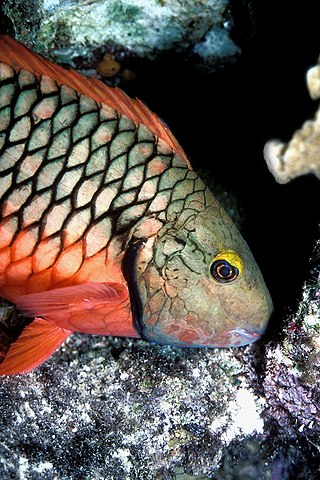
Sparisoma is a genus of parrotfishes native to warmer parts of the Atlantic. FishBase recognizes 15 species in this genus, including S. rocha described from Trindade Island in 2010 and S. choati described from the East Atlantic in 2012. They are the most important grazers of algae in the Caribbean Sea, especially since sea urchins, especially Diadema, the other prominent consumers of algae, have been reduced in many places by a recent epidemic.

Acanthurus bahianus, the ocean surgeon or ocean surgeonfish, is a species of marine ray-finned fish belonging to the family Acanthuridae, the surgeonfishes, unicornfishes and tangs. This species is found on reefs in the Atlantic Ocean off the coast of Brazil. It is sometimes marketed as a food item, but it is more often used as bait, or in tropical saltwater aquaria.

Halichoeres are a genus of wrasses found in the Atlantic, Indian and Pacific Oceans.
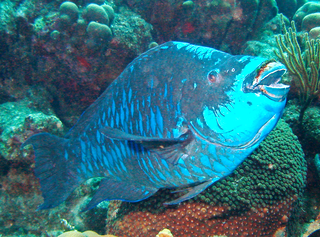
The midnight parrotfish is a species of parrotfish that inhabits coral reefs mainly in the Caribbean, Bahamas, and Florida.

The stoplight parrotfish is a species of marine ray-finned fish, a parrotfish from the family Scaridae, inhabiting coral reefs in Florida, Caribbean Sea, Gulf of Mexico, Bermuda and as far south as Brazil. It mainly feeds on algae by scraping and excavating it with its teeth. Like most of its relatives, it is able to change sex.
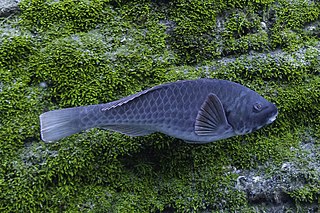
The Mediterranean parrotfish is a species of parrotfish found at depths up to 50 m (160 ft) along rocky shores in the Mediterranean and the eastern Atlantic, from Portugal south to Senegal. It is generally common, but uncommon or rare in the northwestern Mediterranean and in the Adriatic Sea. It prefers relatively warm temperatures and there is an ongoing northward range expansion, possibly due to global warming. The primary adult habitat is rocky reefs, especially in areas with macroalgae, but they may visit adjacent seagrass patches. Juveniles also occur more widely in the latter habitat.

The queen parrotfish is a species of marine ray-finned fish, a parrotfish, in the family Scaridae. It is found on reefs in the tropical West Atlantic Ocean and the Caribbean Sea. Other common names include blownose, blue chub, blue parrotfish, blueman, joblin crow parrot, moontail, okra peji and slimy head. The young males and adult female queen parrotfish are a reddish-brown color, and quite different in appearance from the bluish-green color of the final phase male. This is a common species throughout its range and the International Union for Conservation of Nature has rated its conservation status as "least concern".
Sparisoma tuiupiranga is a species of marine ray-finned fish, a parrotfish from the family Scaridae. It has a single midventral scale posterior to the insertion of the pelvic fins. Its distribution extends from 18°S to 27°S in the western Atlantic, off the coast of Brazil. This species is found in shallow areas of tropical rocky reefs. The males establish territories of approximately eight square metres. The juveniles have a strong association with seaweed beds where they occasionally mix with Sparisoma radians and Cryptotomus roseus. It grazes on a wide variety of algae growing on rocks and so ingests a large amount of sediment. It can be adaptable in its feeding habits and is frequently seen feeding over Sargassum.

Scarus frenatus is a species of parrotfish. Common names include bridled parrotfish, sixband or six-banded parrotfish or vermiculate parrotfish.

Sparisoma chrysopterum is a species of parrotfish.

Sparisoma aurofrenatum is a species of parrotfish native to the Caribbean Sea and Western Atlantic Ocean.
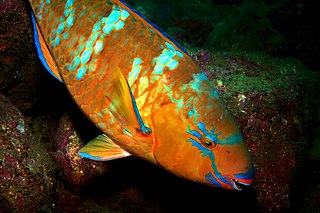
Scarus ghobban, also known as the blue-barred parrotfish, blue trim parrotfish, cream parrotfish, globe-headed parrotfish, green blotched parrotfish, yellow scale parrotfish, and bluechin parrotfish, is a species of marine ray-finned fish in the family Scaridae.

Luiz Alves Rocha is the Curator and Follett Chair of Ichthyology at the California Academy of Sciences. He is also an adjunct professor at the University of California Santa Cruz and San Francisco State University.
Epiperipatus machadoi is a species of velvet worm in the Peripatidae family. This species is dark brown with a series of light brown arcs on each side forming circles down its back and ranges from 20 mm to 66 mm in length. Males of this species have 27 to 29 pairs of legs, usually 28; females have 28 to 31, usually 31. The type locality is in Minas Gerais, Brazil.
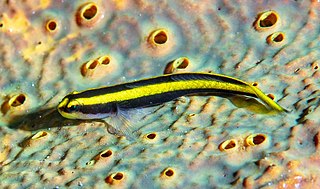
Elacatinus pridisi is a species of goby endemic to the islands of Trindade and Martin Vaz and the seamounts associated to these islands in Brazil. Like other species of the genus Elacatinus, it engages in cleaning behavior. However, unlike other cleaners, it lives in association with both sponges and Montastrea cavernosa instead of only coral. It was also recorded in association with sea urchins.
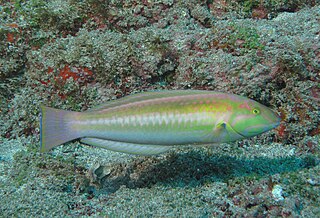
Halichoeres rubrovirens, the red-green wrasse, is a species of wrasse native to the western Atlantic Ocean, being found in the islands of Trindade and Martim Vaz in southeastern Brazil. It's found on rocky reefs at depths of 5-30m, and juveniles seem to mimic and usually school together with Thalassoma noronhanum which they resemble in color. They are not genetically close to any other species of Halichoeres in the Atlantic, and are likely a relict species.

Sparisoma choati, the West-African parrotfish, is a species of marine ray-finned fish from the family Scaridae. It occurs at depths between 2 and 30m, along west African coastline and islands from Cape Verde and Senegal south to the offshore islands of the Gulf of Guinea and northern Angola. Like other parrotfish of the genus Sparisoma, it lives on rocky reefs and grazes on algae growing over hard substrate. It was named in honor of J. Howard Choat, in recognition of his extensive scientific work on parrotfishes.

Sparisoma rubripinne, which also goes by the common names yellowtail parrotfish or redfin parrotfish is a species of parrotfish in the genus Sparisoma. It can be found in the Western Atlantic Ocean, and is primarily found in the Caribbean Sea.

Scarus zelindae is a species of fish of the Scaridae family in the order Perciformes. This species of Parrotfish can be brown, blue, green, yellow, and purple and can change their colors several times throughout their lifetime. They live for about 5–7 years and can be found in the southwestern Atlantic Ocean, primarily in Brazilian waters.

















